#Assyrian Kings
Explore tagged Tumblr posts
Photo
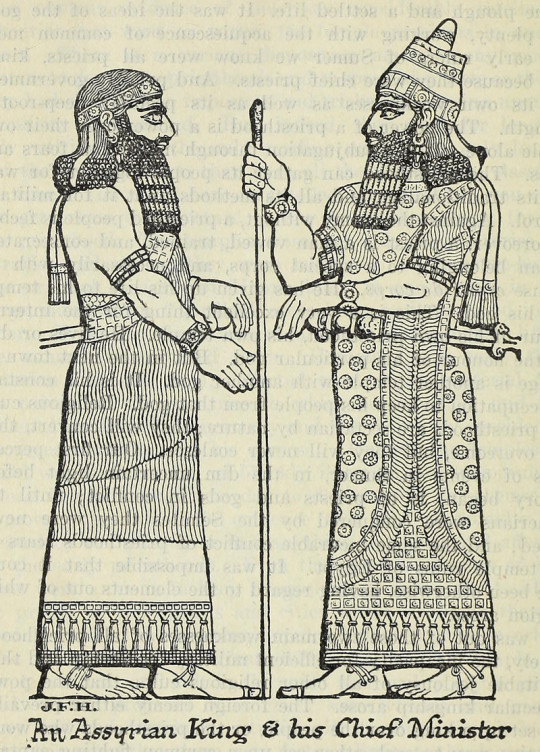
Source details and larger version.
Some rather surprising crowned heads are collected in my king gallery.
33 notes
·
View notes
Text
Handshake
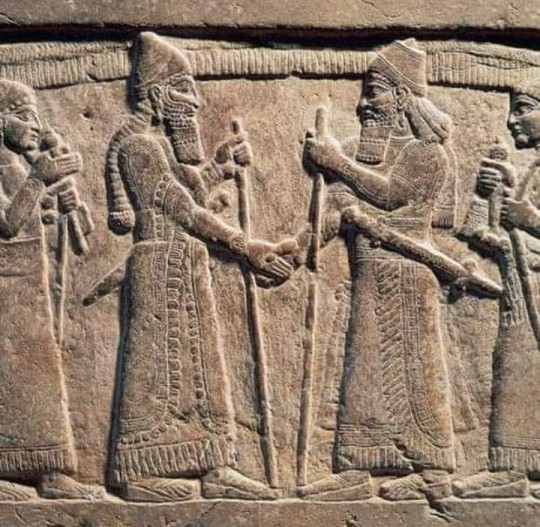
Assyrian Relief of the Peace Agreement between the Assyrian King Shalmaneser III, while receiving the King of Babylon, Marduk Zakir Shumi (9th century BC).
This ritual gesture has existed since ancient times, but its use as an everyday greeting is a more recent phenomenon.
The handshake has existed in some form or another for thousands of years, but its origins are somewhat murky. One popular theory is that the gesture began as a way of conveying peaceful intentions.
By extending their empty right hands, strangers could show that they were not holding weapons and bore no ill will toward one another.
Some even suggest that the up-and-down motion of the handshake was supposed to dislodge any knives or daggers that might be hidden up a sleeve.
Yet another explanation is that the handshake was a symbol of good faith when making an oath or promise. When they clasped hands, people showed that their word was a sacred bond.
“An agreement can be expressed quickly and clearly in words,” historian Walter Burkert once explained, “but is only made effective by a ritual gesture: open, weaponless hands stretched out toward one another, grasping each other in a mutual handshake.”
One of the earliest depictions of a handshake is found in a 9th century BC relief, which shows Assyrian King Shalmaneser III pressing flesh with a Babylonian ruler to seal an alliance.
Epic poet Homer described handshakes several times in his “Iliad” and “Odyssey,” most often in relation to pledges and displays of trust.
The gesture was also a recurring motif in 4th-5th century BC. Greek funerary art and gravestones would often depict the deceased person shaking hands with a member of their family, signifying either a final farewell or the eternal bond between the living and the dead.
In ancient Rome, meanwhile, the handshake was often used as a symbol of friendship and loyalty. Pairs of clasped hands even appeared on Roman coins.
📍British Museum
#handshake#ritual gesture#Assyrian King Shalmaneser III#Marduk Zakir Shumi#symbok#symbol#good faith#oath#promise#homer#illiad#odyssey#friendship#loyalty#gesture
15 notes
·
View notes
Text
Assyrian rock relief in the Iran

The Shikaft-e Golgol-Gulgul site is indeed a significant historical and archaeological location in Iran, featuring an Assyrian rock relief and inscription.
The inscription refers to the conquest of Elam and Lorestan by the Assyrians. This reflects the expansion of the Assyrian Empire into these regions.
The Assyrian Empire, which existed from roughly the 25th century BC to the 7th century BC, was known for its military prowess and expansive territorial control.
The relief at Shikaft-e Golgol-Gulgul is a testament to their reach and influence in the ancient world. Such inscriptions and reliefs are invaluable for understanding the history, culture, and political dynamics of the Assyrian Empire and its interactions with neighboring regions like Elam and Lorestan.
#ancient mesopotamia#mesopotamia#archaeology#ancient history#akkadian#ancient iran#history of mesopotamian kings#ancient empire#assyrian empire
30 notes
·
View notes
Text
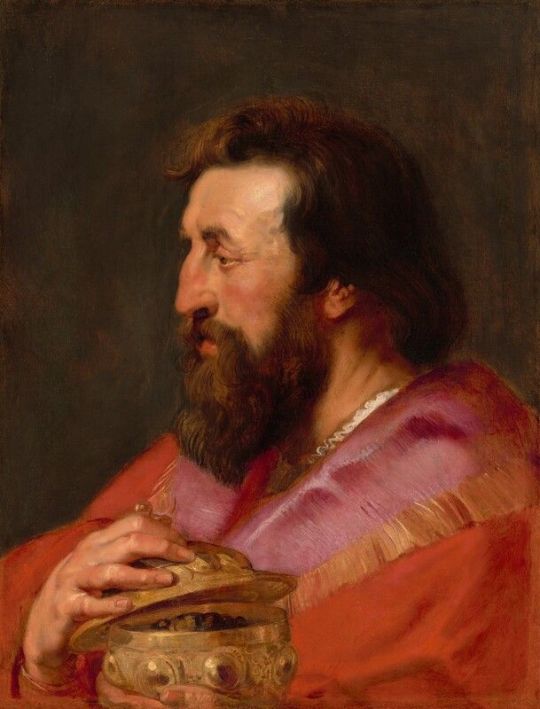
Head of One of the Three Kings: Melchior, The Assyrian King
Artist: Sir Peter Paul Rubens (Flemish, 1577-1640)
Date: ca. 1618
Medium: Oil on panel transferred to canvas
Collection: National Gallery of Art, Washington, DC, United States
Description
Peter Paul Rubens painted this compelling image of one of the three Magi around 1618 for his childhood friend Balthasar Moretus the Elder (1574–1641), owner of the prestigious Plantin Press in Antwerp. Traditionally identified as Melchior, the Assyrian king, this profile image of a middle-aged man with a full beard is not shown as an exotic king from a distant past but as a tangible flesh and blood figure with a powerful three-dimensional presence. Wearing a sumptuous scarlet robe, he has just started to open his gilded vessel, revealing his gift of frankincense. Biblical commentators interpreted Melchior's gift, which was burnt as incense in biblical times, as representing sacrifice, prayer, and the recognition of Christ's divine majesty.
#artwork#portrait#bust length#biblical#melchior#assyrian king#middle age man#bearded man#scarlet robe#gilded vessel#frankincense#biblical art#christianity#christian art#painting#oil on panel#oil painting#flemish culture#flemish art#peter paul rubens#flemish painter#european art#art and the bible#17th century painting#national gallery of art
6 notes
·
View notes
Text
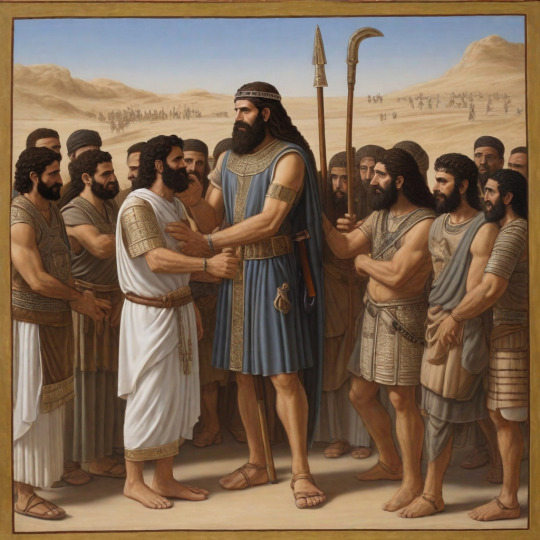
Samaria, 853 BCE Israelite king Ahab during a reunion with members of the anti-Assyrian coalition in preparation for the Battle of Qarqar.
#qarqar#israel#samaria#ancient times#conflict#ai prompt#prompter art#leonardo ai#king ahab#israelite#assyrian#middle east
12 notes
·
View notes
Text
King’s Approval for Assyrian scribes
The Assyrian records read, on the other hand, as if they were the work of royal scribes, writing under the direct supervision of the kings themselves. The gods are described, and their varied relations to the world below are duly set forth. But the emphasis of the narrative appears to be given to the glory and the achievements of such great monarchs as Sargon and Asshurbanipal, as if a long line of scribes, writing directly for the king’s approval, had continued the chronicles from reign to reign.
Authors and their public in ancient times by George Haven Putnam http://www.gutenberg.org/ebooks/72922
3 notes
·
View notes
Text
From Glory to Grief
Three Kings and the Rise and Fall of JudahThru the Bible in a Year Some chapters in Scripture hit like a royal drama, filled with power, prayer, pride, and pain. Today’s journey through 2 Kings 19–21 reads like such a story. We witness the reign of three kings—Hezekiah, Manasseh, and Amon—and with them, we see how the choices of leaders shape the spiritual and moral temperature of a nation.…
#2 Kings 19–21#Assyrian invasion#Bible study blog#biblical history#biblical kings#biblical leadership lessons#Christian character#church Bible reading plan#daily spiritual discipline#devotional reflections#faithful leadership#intentional faith#Isaiah’s prophecy#Judah kings#judgment and mercy#King Amon#King Hezekiah#King Manasseh#kingdom influence#Old Testament leadership#Old Testament narrative#prayer in crisis#pride and downfall#prophetic rebuke#spiritual growth#spiritual legacy#Thru the Bible in a Year
0 notes
Text
Reign of Zedekiah: Historical Context and Prophetic Warnings
Nebuchadnezzar's invasion of Jerusalem, which took place in the 6th century B.C., marked a pivotal moment in the history of the region.
Photo by Emran Yousof on Unsplash | Commercial use allowed 1. Expository Study of 1 Nephi 1:4 in the Context of the Reign of Zedekiah The historical background of the reign of Zedekiah provides crucial context for understanding the events described in 1 Nephi 1:4. Zedekiah ascended to the throne of Judah amidst a time of political and social turmoil. The people had become rebellious against the…

View On WordPress
#1 Nephi 1:4#Archaeology#Assyrian Empire#Babylonian captivity#Book of Mormon#Egyptian Empire#King Nebuchadnezzar#Lehi#Political Corruption#Prophetic Warnings#Scripture Commentary#Social unrest#Zedekiah
0 notes
Text
The bronze head known as 'Sargon of Akkad' is a masterpiece of Assyrian sculpture dating to the 24th century BC. It depicts an Assyrian ruler, possibly Sargon I, one of the earliest kings of the Assyrian Empire.
La cabeza de bronce conocida como "Sargón de Acad" es una obra maestra de la escultura asiria que data del siglo XXIV a.C. y representa a un gobernante asirio, posiblemente Sargón I, uno de los primeros reyes del Imperio Asirio.
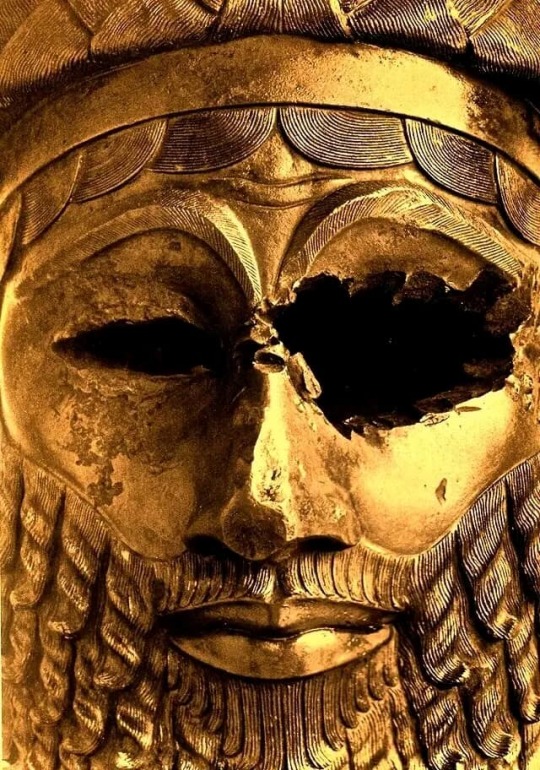
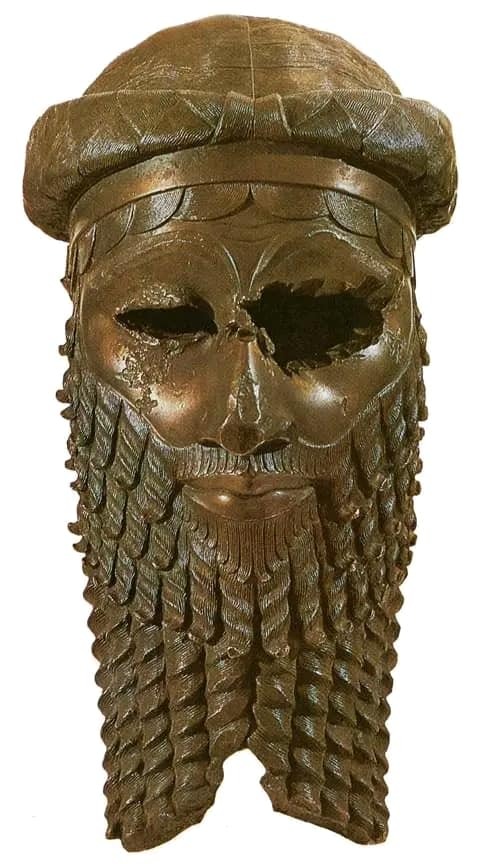
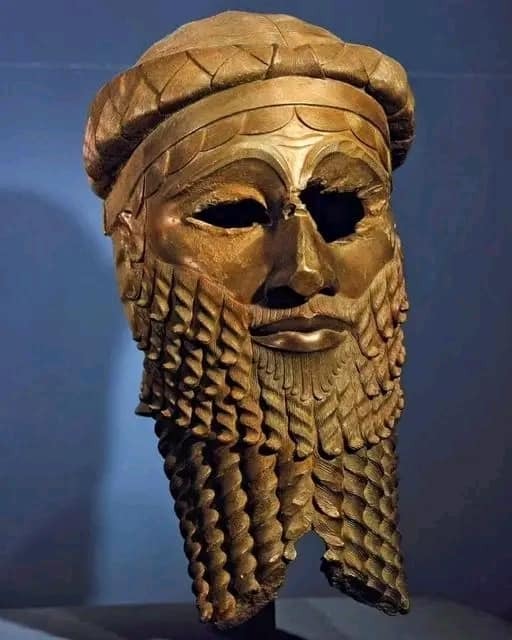
(Español / English)
Origen y descubrimiento: La cabeza de bronce de "Sargón de Acad" fue descubierta en 1976 en la ciudad de Acad, una antigua ciudad asiria ubicada en lo que hoy es Iraq. Fue encontrada en las ruinas de un palacio durante excavaciones arqueológicas dirigidas por el arqueólogo iraquí Tariq Madhloom.
Fecha y contexto: Se cree que la cabeza de bronce data del período acadense, alrededor del siglo XXIV a.C. Durante este tiempo, Acad era una de las principales ciudades del Imperio Asirio, y la escultura refleja el estilo artístico de esa época.
Identificación: Aunque la identidad exacta del gobernante representado en la cabeza de bronce no está confirmada, se ha sugerido que podría ser Sargón I, un rey asirio que vivió alrededor del siglo XXIV a.C. Sin embargo, esta identificación no es definitiva y sigue siendo objeto de debate entre los expertos.
Importancia histórica y cultural: La cabeza de bronce de "Sargón de Acad" es una pieza invaluable de la historia y el arte asirio. Representa una época importante en el desarrollo del Imperio Asirio y proporciona información valiosa sobre el arte y la cultura de la región en ese período. Además, la cabeza de bronce es un testimonio del alto nivel de habilidad artística y técnica alcanzado por los escultores asirios hace más de 4000 años.
Fuente: Descubriendo el pasado en facebook.
***
Origin and discovery: The bronze head of 'Sargon of Akkad' was discovered in 1976 in the city of Akkad, an ancient Assyrian city in present-day Iraq. It was found in the ruins of a palace during archaeological excavations led by Iraqi archaeologist Tariq Madhloom.
Date and context: The bronze head is thought to date to the Akkadian period, around the 24th century BC. During this time Akkad was one of the major cities of the Assyrian Empire, and the sculpture reflects the artistic style of the period.
Identification: Although the exact identity of the ruler depicted on the bronze head is not confirmed, it has been suggested that he may be Sargon I, an Assyrian king who lived around the 24th century BC. However, this identification is not definitive and remains the subject of debate among scholars.Identification: Although the exact identity of the ruler depicted on the bronze head is not confirmed, it has been suggested that he may be Sargon I, an Assyrian king who lived around the 24th century BC. However, this identification is not definitive and is still under discussion among experts.
Historical and cultural significance: The bronze head of 'Sargon of Akkad' is an invaluable piece of Assyrian history and art. It represents an important period in the development of the Assyrian Empire and provides valuable information about the art and culture of the region at that time. In addition, the bronze head is a testimony to the high level of artistic and technical skill achieved by Assyrian sculptors more than 4,000 years ago.
#assyrian history#king sargon#24th century BC#assyrian empire#imperio asirio#sargon de acad#s. XXIV a.C.#arte asirio
1 note
·
View note
Text
Samaria
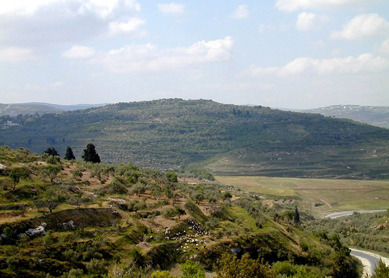
View On WordPress
#Assyrians#Baal worship#Bible#Capital of Israel#Elijah#Exile#Jesus#Jezebel#King Ahab#King Hoshea#King Omri#Nothern kingdom#Samaria#Woman at the well
0 notes
Text
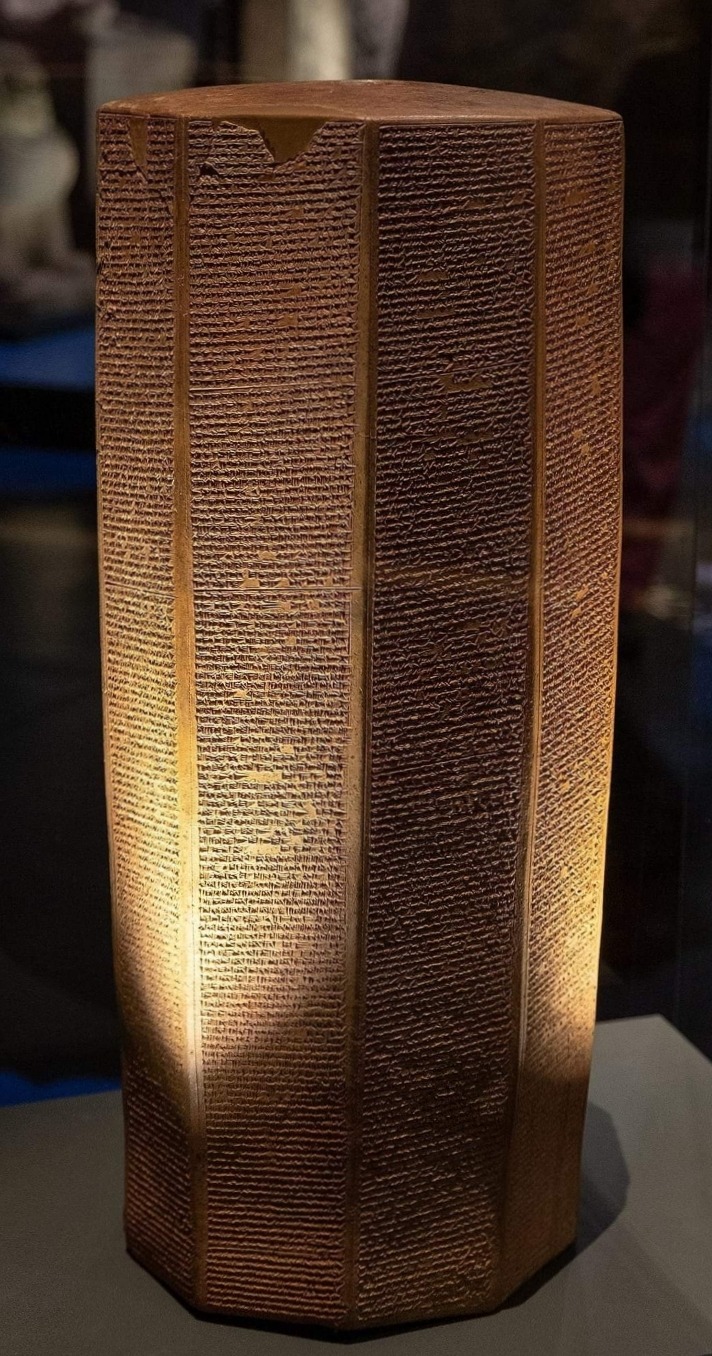
Rassam Cylinder, a ten-sided clay cylinder that was created in c. 643 BC, during the reign of King Ashurbanipal (c. 685 BC - 631 BC) who ruled the Neo-Assyrian Empire from 669 - 631 BC.
It was discovered in the ancient Assyrian city of Nineveh, near Mosul, present-day Iraq, by Hormuzd Rassam (3 October 1826 - 16 September 1910) in 1854.
In over 1,300 lines of cuneiform text, the cylinder records nine military campaigns of Ashurbanipal, including his wars with Egypt, Elam and his brother, Shamash-shum-ukin.
It also records his accession to the throne and his restoration of the Palace of Sennacherib.
The cylinder is the most complete chronicle on the life of Ashurbanipal.
There are some extracts from the cylinder below:
"I am Ashurbanipal, offspring of Ashur and Bêlit, the oldest prince of the royal harem, whose name Ashur and Sin, the lord of the tiara, have named for the kingship from earliest (lit., distant) days, whom they formed in his mother's womb, for the rulership of Assyria; whom Shamash, Adad and Ishtar, by their unalterable (lit., established) decree, have ordered to exercise sovereignty.
Esarhaddon, king of Assyria, the father who begot me, respected the word of Ashur and Bêlit-ilê (the Lady of the Gods), his tutelary (divinities), when they gave the command that I should exercise sovereignty.
In the month of Airu, in the month of Ea, the lord of mankind, the twelfth day, an auspicious day, the feast day of Gula, at the sublime command which Ashur, Bêlit, Sin, Shamash, Adad, Bêl, Nabû, Ishtar of Nineveh, Queen of Kidmuri, Ishtar of Arbela, Urta, Nergal, Nusku, uttered, he gathered together the people of Assyria, great and small, from the upper to (lit., and) lower sea.
That they would accept (lit., guard) my crown princeship, and later my kingship, he made them take an oath by the great gods, and so he strengthened the bonds (between them and me)....
By the order of the great gods, whose names I called upon, extolling their glory, who commanded that I should exercise sovereignty, assigned me the task of adorning their sanctuaries, assailed my opponents on my behalf, slew my enemies, the valiant hero, beloved of Ashur and Ishtar, scion of royalty, am I.
Egyptian Campaign:
"In my first campaign I marched against Magan, Meluhha, Taharqa, king of Egypt and Ethiopia, whom Esarhaddon, king of Assyria, the father who begot me, had defeated, and whose land he brought under his sway.
This same Taharqa forgot the might of Ashur, Ishtar and the other great gods, my lords, and put his trust upon his own power.
He turned against the kings and regents whom my own father had appointed in Egypt.
He entered and took residence in Memphis, the city which my own father had conquered and incorporated into Assyrian territory.
A swift courier came to Nineveh and reported to me.
At these deeds, my heart became enraged, my soul cried out. I raised my hands in prayer to Ashur and the Assyrian Ishtar.
I mustered my mighty forces, which Ashur and Ishtar had placed into my hands. Against Egypt and Ethiopia, I directed the march."
Rassam Cylinder records the reign of Ashurbanipal until c. 645 BC.
The latter years of his reign are poorly recorded, probably due to the fact that the Neo-Assyrian Empire was plagued with troubles.
One of Ashurbanipal's last known inscription reads:
"I cannot do away with the strife in my country and the dissensions in my family; disturbing scandals oppress me always.
Illness of mind and flesh bow me down; with cries of woe I bring my days to an end.
On the day of the city god, the day of the festival, I am wretched; death is seizing hold upon me, and bears me down..."
Rassam Cylinder is currently on display in the British Museum.
A truly remarkable, yet biased, insight into the reign of Ashurbanipal and the world in which he lived.
📷: © Anthony Huan
#Rassam Cylinder#King Ashurbanipal#Neo-Assyrian Empire#Nineveh#Hormuzd Rassam#clay cylinder#cuneiform text#Palace of Sennacherib#British Museum#Assyria#ancient civilizations#Iraq#assyriology#military campaigns#cuneiform cylinder#cuneiform#writing systems
56 notes
·
View notes
Text

The coronation of the king of Assyria by the gods
The Assyrian king receives the insignia of power from the gods Aššur (Ashur) and Ištar (Ishtar).
Ashur is in front of the Assyrian king and Ishtar is behind him and puts the king's hat on the king's head.
Read More:
What does ashurbanipal name mean (Text Post)
How does Ashurbanipal introduce himself (Text Post)
#archaeology#ancient mesopotamia#mesopotamia#ancient history#akkadian#ancient iraq#ancient assyria#assyrian#ancient empire#ancient assyrian king#history of mesopotamian kings#history of ancient assyrfia#god of ashur#god of ishtar#gods of mesopotamia
11 notes
·
View notes
Photo

(via I will Deliver Isaiah's Prophetic Book Pt100 on Battle Lines)
I will Deliver Isaiah’s Prophetic Book Pt100 on Battle Lines
https://warn-usa.com/i-will-deliver-isaiahs-prophetic-book-pt100/
I will Deliver brings to the table of God’s deliverance of Judah from the Assyrians, but the King was going to die. The prophet Isaiah gave the message to the King. In these troubles the King repented, sought God, and the Lord ended up being the deliverer. I will deliver thee brought the threat of an enemy to an end and the deliverance of the King from Death. Yet coming is another message on the heels of the chapter we are in. In this we find the ominous Babylon showing up.
👀👀👀Read more, continue to post:
Be sure to visit our websites: Warn-Usa.com | DanaGlennSmith.com
Who is the WIBR/WARN Radio?
For over Twenty-Five years WIBR/WARN Radio had been in this endtime Ministry which specializes in media, in-depth articles, books, Radio shows, podcasts, and websites. We bring the gospel message worldwide through our websites and our Warn Radio Network of providers we work with. WIBR/WARN Radio shows are aired three times weekly with Dana Glenn Smith as the Watchman alongside Tower co-host.
0 notes
Text
Dual Fulfilment of Scripture
Ecclesiastes 1:9 The thing that hath been, it is that which shall be; and that which is done is that which shall be done: and there is no new thing under the sun. These modern day countries make up the region which compromised the Seleucid kingdom of the past from which the King of the North, the forerunner or type of Antichrist, Antiochus IV Epiphanes came from, which will also be the region or…
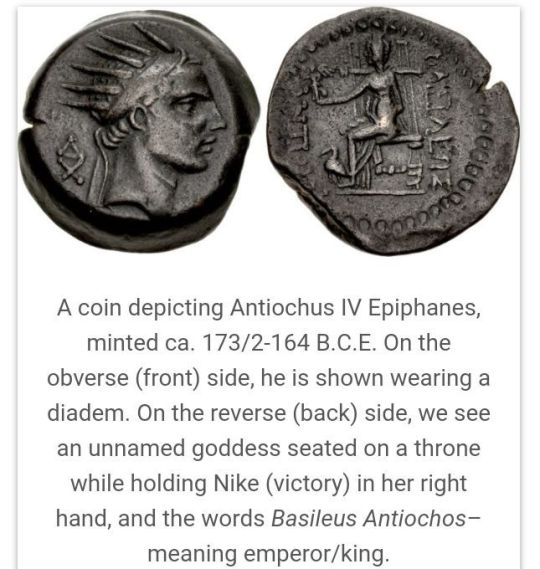
View On WordPress
0 notes
Text
“Two Kingdoms, One Warning”
Thru the Bible in a Year Reading through 2 Kings 17 and 18, we encounter two vastly different stories—one tragic, the other hopeful. It’s almost as if we are reading two endings in the same book. In chapter 17, the northern kingdom of Israel collapses into ruin, dragged into captivity by Assyria. By contrast, in chapter 18, Judah, the southern kingdom, experiences a revival under King Hezekiah’s…
#2 Kings 17#2 Kings 18#Assyrian captivity#Bible reading plan#biblical history#biblical warnings#Christian discipline#Christian living#daily devotional#faithfulness#fall of Israel#idolatry#intentional faith#Judah&039;s revival#judgment and mercy#King Hezekiah#King Hoshea#national repentance#Old Testament kings#prophetic warnings#R.C. Sproul#revival#spiritual compromise#spiritual leadership#Thru the Bible#trust in God#Warren Wiersbe
0 notes
Text

king david had red hair before we were colonized but okay.




palestinians lmao
more light haired palestinian kids from their own propaganda videos:





ope guess they’re white people. same with black africans who have red hair!
just tell me you don’t know what the fuck genetic diversity is or how it works. it’s amazing how “progressives” who claim to love diversity echo so many racist, straight up eugenicist talking points and have no understanding of actual diversity.
i wont get into levantine groups like assyrians, yazidis, JEWS, kurds, samaritans, etc all having light hair and eye genes. (and guess what, arabs and turks have them too, as seen above 🙄🤦)
learn some fucking science jfc
698 notes
·
View notes